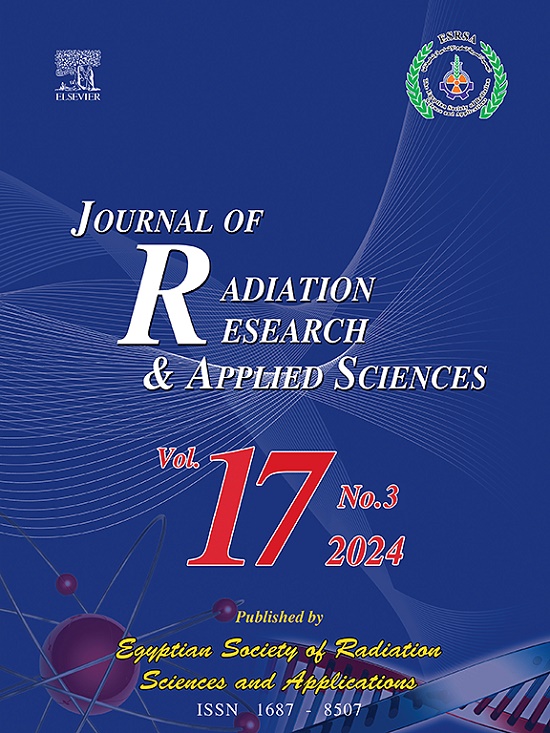利用人工神经网络方法评估填充三元混合纳米流体的多孔矩形润湿鳍片的热导率
IF 1.7
4区 综合性期刊
Q2 MULTIDISCIPLINARY SCIENCES
Journal of Radiation Research and Applied Sciences
Pub Date : 2024-09-23
DOI:10.1016/j.jrras.2024.101125
引用次数: 0
摘要
本研究分析了在局部热非均衡(LTNE)模型下,具有绝热顶端的固定长度的湿润矩形多孔鳍片的温度传输,以及对流和辐射效应的影响。通过使用达西模型和布西内斯克近似法,考虑了浮力的影响,以估算渗透材料内部的渗透速度。数学模型推导出两个能量方程(固态和流态)。流体状态由 MoS2+Fe3O4+NiZnFe2O4 纳米粒子组合的三元混合纳米流体和甲醇作为基础流体组成。此外,利用无量纲变量将这两个方程转换为无量纲非线性常微分方程,并利用 Runge Kutta Fehlberg 四阶五次方(RKF 45)对这些方程进行求解。此外,还通过应用 Levenberg Marquart 反向传播算法,使用人工神经网络对平均努塞尔特数进行了分析。通过使用该算法,对神经网络的回归分析、均方误差和误差直方图进行了分析。在该模型中,对三种不同类型的样本进行了研究,其中 80% 的数据点用于训练神经网络,10% 用于测试,10% 用于验证人工神经网络(ANN)模型。通过图表显示了温度曲线和平均努塞尔特数等重要方面的优越性。然而,从结果中可以发现,表面-环境辐射参数水平降低了,固相和三元纳米流体相的温度曲线都增加了。从 ANN 模型中得到的回归系数值为 R=1 f,这意味着参数之间具有很强的相关性。本文章由计算机程序翻译,如有差异,请以英文原文为准。
Leveraging artificial neural networks approach for thermal conductivity evaluation in porous rectangular wetted fins filled with ternary hybrid nanofluid
The present work deals the temperature transmission of wetted rectangular porous fins of fixed length with an adiabatic tip under Local Thermal Non-Equilibrium (LTNE) model is analysed with the influence of convection and radiation effects. By using the Darcy model and Boussinesq's approximation, the impacts of buoyancy force are considered to estimate the penetration speed within the permeable material. Two energy equations (Solid and Fluid state) are derived for the mathematical model. The fluid state consists of ternary hybrid nanofluid with a combination of nanoparticles with methanol as a base fluid. In addition, both equations are converted to dimensionless non-linear ordinary differential equations by using dimensionless variables, and these equations are solved by using Runge Kutta Fehlberg fourth fifth-order (RKF 45). Further, the average Nusselt number is analysed using an Artificial neural network by applying the Levenberg Marquart backpropagations algorithm. By using this algorithm, the regression analysis, mean square error, and error histogram of the neural network are analysed. In this model, three distinct types of samples are examined, comprising 80% of data points allocated for training the neural network, 10% for testing, and 10% for validation of the artificial neural network (ANN) model. The supremacy of essential aspects of the temperature profile and average Nusselt number is displayed through graphs. However, it is noticed from the results that the surface-ambient radiation parameter levels are decreased and the temperature profile of both solid and ternary nanofluid phase is augmented. The regression coefficient value obtained from ANN model is f, which means the parameters are in strong correlation with each other.
求助全文
通过发布文献求助,成功后即可免费获取论文全文。
去求助
来源期刊

Journal of Radiation Research and Applied Sciences
MULTIDISCIPLINARY SCIENCES-
自引率
5.90%
发文量
130
审稿时长
16 weeks
期刊介绍:
Journal of Radiation Research and Applied Sciences provides a high quality medium for the publication of substantial, original and scientific and technological papers on the development and applications of nuclear, radiation and isotopes in biology, medicine, drugs, biochemistry, microbiology, agriculture, entomology, food technology, chemistry, physics, solid states, engineering, environmental and applied sciences.
 求助内容:
求助内容: 应助结果提醒方式:
应助结果提醒方式:


